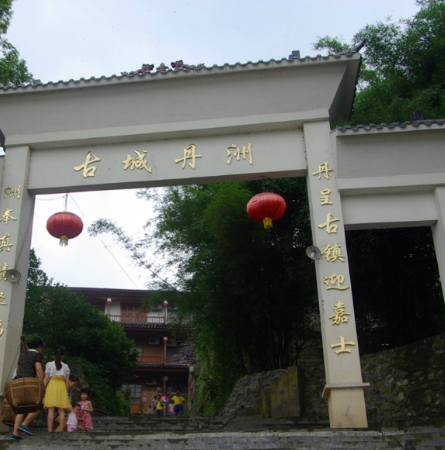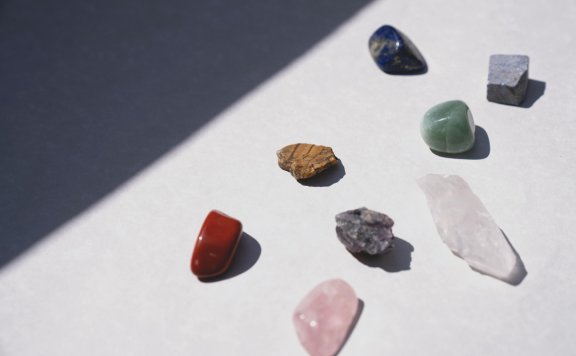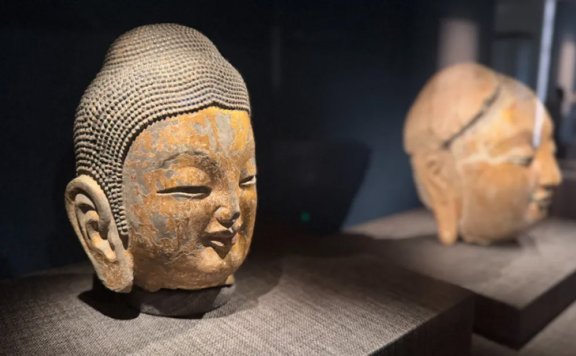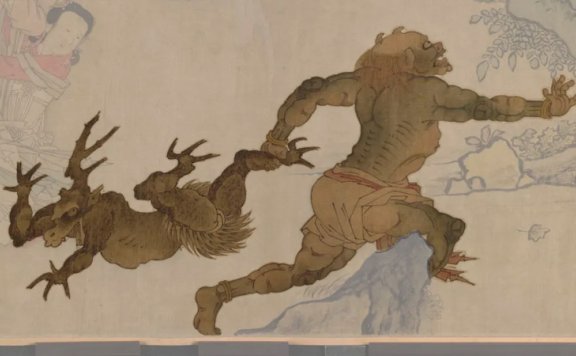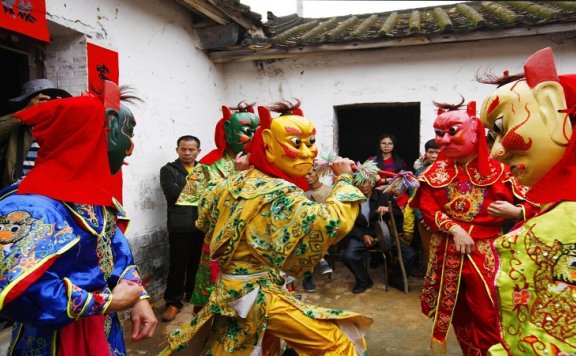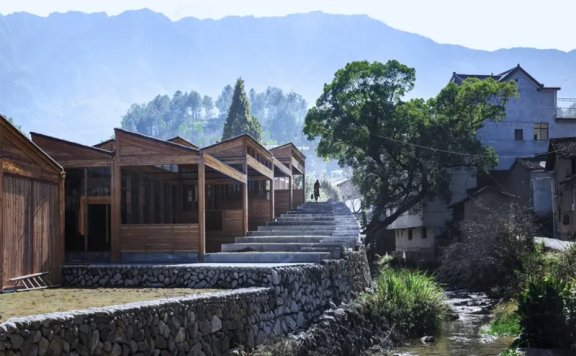Article
搜索结果:
-
Top 10 Famous Dishes in Yunnan
Yunnan, a province in southwestern China, is renowned for its diverse and flavorful cuisine. Here is a list of the top 10 famous dishes in Yunnan, each with its unique taste and cultural significance. 1. Dali Clay Pot Fish (Dali Shaguo Yu) Category: Yunnan - Guizhou Cuisine Origin: Dali Description: Dali Clay Pot Fish is a local delicacy made with fresh fish from Erhai Lake, cooked in a clay pot from Xiangyun. The dish is rich in flavor, with tender fish meat and a fragrant broth. It is often served on a large plate with leafy greens, creating a colorful and aromatic presentation. 2. Old Kunming Lamb Hotpot (Lao Kunming Yangtang Guo) Category: Yunnan Cuisine Description: This classic Yunnan dish features lamb meat and offal, slow - cooked to perfection. The broth is rich and flavorful, with a spicy and aromatic dipping sauce. The dish is a favorite among locals for its hearty and comforting taste. 3. Dali Raw Pork (Dali Shengpi) Category: Meat Dish Origin: Yunnan Description: Dali Raw Pork is a traditional Bai ethnic dish, made with thinly sliced pork and a variety of dipping sauces. The pork is fresh and tender, with no special smell, and is… -
Top 10 Tibetan Cuisine Delicacies
Tibetan cuisine is renowned for its unique flavors and rich cultural heritage. Here’s a curated list of the top 10 must-try dishes from Tibet, each offering a glimpse into the region’s culinary traditions. 1. **Tun Guanchang (Boiled Sausage)** A staple in Tibetan households, this dish features sheep intestines stuffed with a mix of blood, meat, and barley or bean flour. It’s traditionally prepared during festivals and loved for its distinctive texture and flavor. 2. **Zheng Niushe (Steamed Beef Tongue)** A tender and aromatic delicacy, steamed beef tongue is lightly seasoned to highlight its natural taste. Often served cold or hot, it’s a favorite for its simplicity and rich flavor. 3. **Zha Guanfei (Fried Lung Sausage)** A crispy and savory snack made from sheep lungs, butter, and flour. Its origins trace back centuries, and it remains a popular street food in Lhasa. 4. **Suancai Miankuai (Sour Vegetable Noodles)** A comforting dinner dish combining homemade sour vegetables, hand-pulled noodles, and local dried meat or yak beef. The tangy, spicy broth is both hearty and refreshing. 5. **Gangba Kao Quanyang (Gangba Roast Whole Lamb)** A celebratory dish, this roast lamb is marinated with local spices and slow-cooked to perfection. The meat is juicy… -
Top 10 Most Beautiful Ancient Towns in Guangxi
Guangxi, the only coastal minority autonomous region in China, boasts numerous well - preserved ancient towns that are witnesses to the region's rich history and culture. Here's a list of the top 10 most beautiful ancient towns in Guangxi that you shouldn't miss. 1. Danzhou Ancient Town (Liuzhou) Danzhou Ancient Town, established during the Ming Dynasty over 400 years ago, is a unique floating town accessible only by ferry. Its crystal - clear waters, lush vegetation, and serene atmosphere make it a perfect escape from urban life. 2. Naliang Ancient Town (Fangchenggang) Naliang Ancient Town is renowned for its well - preserved historical architecture, including four ancient streets. The town's Hakka culture and riverside bamboo buildings add to its charm. 3. Daxu Ancient Town (Guilin) With a history dating back to the Northern Song Dynasty, Daxu Ancient Town is famous for its riverside architecture, ancient streets, and picturesque scenery. 4. Luxu Ancient Town (Nanning) Luxu Ancient Town is a blend of history, culture, and cuisine, featuring ancient buildings and temples that showcase its rich heritage. 5. Xing'an Ancient Town (Guilin) Xing'an Ancient Town combines Qin and Han cultures with Central Plains and Lingnan cultures. Its ancient bridges and riverside architecture… -
The Historical Evolution of the Horse-Face Skirt
The horse-face skirt (mamianqun), with its distinctive overlapping panels and intricate pleats, stands as a timeless symbol of Chinese fashion ingenuity. For nearly a millennium, this garment evolved alongside dynastic shifts, social norms, and artistic innovations. Today, it’s experiencing a global renaissance, embraced by Hanfu enthusiasts and haute couture designers alike. In this article, we unravel its remarkable journey from the Song Dynasty’s utilitarian xuanqun to the Qing Dynasty’s lavish pleated masterpieces. 1. Song Dynasty Origins: The Birth of the Xuanqun (10th–13th Century) The horse-face skirt’s story begins in the Song Dynasty (960–1279), an era marked by economic prosperity and technological advancements in textile production. Practical Design for Active Lifestyles The early prototype, called xuanqun (旋裙, “rotating skirt”), featured a two-panel split design that allowed freedom of movement. Unlike later elaborate versions, it prioritized functionality: Worn by working-class women for tasks like horseback riding and farming. Lightweight fabrics like silk gauze ensured breathability. Minimal pleating focused on ease of movement rather than decoration. Archaeological Evidence A pivotal discovery came from Huang Sheng’s Tomb (Fuzhou, 1243 CE), where a well-preserved xuanqun was unearthed: Made of sheer silk with simple knife pleats. Waistband secured with fabric ties, lacking the overlapping panels of later designs. 2. Ming Dynasty Standardization (14th–17th Century) The Ming Dynasty (1368–1644) transformed the xuanqun into… -
The Significance of the Five Elemental Gemstones in Chinese Traditions
Across the globe, gemstones are often valued for their beauty and rarity. However, in Chinese culture, certain gemstones hold an additional layer of significance, deeply rooted in the philosophy of the Five Elements. These elements – Wood, Fire, Earth, Metal, and Water – are fundamental to understanding Chinese cosmology and traditions. This article will explore the unique significance of the five gemstones associated with these elements. The Five Elements and Their Corresponding Gemstones The Wu Xing theory represents a complex web of relationships where elements generate and control one another in specific sequences. Each element corresponds to particular gemstones that channel its distinctive qualities and energies. These associations weren't arbitrary but developed through centuries of observation regarding the stones' physical properties, colors, and perceived energetic effects. 1. Wood Element and Green Stone In Chinese tradition, the Wood element symbolizes growth, vitality, and renewal, much like the energy of spring. It represents expansion, flexibility, and resilience, making it essential for fostering new beginnings. Green jade is the most revered gemstone associated with this element, often called the "stone of heaven." More valuable than gold in ancient China, jade’s smooth and durable nature embodies the Wood element’s strength and adaptability. It is… -
Why Tang Dynasty Style Dominates Costume Dramas
In recent years, costume dramas featuring Tang Dynasty aesthetics have surged in popularity. From the widely acclaimed "The Curse of the Pearl Screen" and "Strange Tales of the Tang Dynasty" to upcoming productions like "National Beauty and Fragrance" starring Yang Zi and Li Xian, "Midnight Return" with Tian Xiwei and Xu Kai, Liu Shishi's "Palm of the Hand," and the adaptation of Ma Boyong's novel "Lychees of Chang'an," the Tang Dynasty has become the go - to historical backdrop for filmmakers. The Tang Dynasty (618 - 907 AD) was a golden age of Chinese civilization, renowned for its cultural confidence and sartorial splendor. As historian Sun Ji noted in "Essays on Ancient Chinese Costumes," Tang noblewomen boldly embraced low - cut dresses that accentuated their beauty. The poet Ouyang Xun famously captured this aesthetic with the line: "Snow - white chests and flower - like faces." Shen Congwen's "History of Chinese Clothing" details how Tang women pioneered fashion trends. The popular "half - sleeve" jacket, worn over narrow - sleeved blouses, featured various collar styles and was tied with delicate ribbons across the chest. The pi (披帛), a long decorative scarf often made of sheer silk with intricate patterns, became… -
Zhao Lusi's Tang Style Evolution in Pearl Curtain and Jade Screen
Zhao Lusi's latest Tang Dynasty-inspired look in 'Pearl Curtain and Jade Screen' has fans reminiscing about her iconic Le Yan (乐嫣) character from 'The Long Ballad' (长歌行). While both styles draw from the Tang Dynasty aesthetic, there are notable differences that showcase her versatility in portraying historical roles. Le Yan's Hairstyle in 'The Long Ballad' In 'The Long Ballad', Zhao's Le Yan character sported the classic 'Bunny Ear' hairstyle, known as Baiheji (百合髻) or Lily Bun. This double-bun style, often with a center part or crisscross design, was popular during Emperor Taizong's reign (627 - 649 AD). Historical records from Ma Gao's 'Notes of Past and Present China' describe it as one of the signature hairstyles of early Tang Dynasty, perfectly complementing Zhao's sweet and youthful appearance. Hairstyle in 'Pearl Curtain and Jade Screen' The 'Pearl Curtain and Jade Screen' presents a more mature interpretation of Tang fashion. Zhao's character wears a single bun hairstyle, reminiscent of the Qiu Ji (囚髻) or Prisoner's Bun popular in mid - late Tang Dynasty. The styling features thinner, more voluminous sideburns creating a 'Chan Bin' (蝉鬓) or Cicada Wing effect - a delicate framing technique that mimics the transparency of cicada wings using… -
Did Ancient Chinese Use Umbrellas on Sunny Days?
We all know that ancient Chinese used umbrellas on rainy days, but did they also use them for sun protection on sunny days? In historical dramas, oil-paper umbrellas are no longer just for rain but have become props to create an aesthetic atmosphere. They are often seen in scenes where the protagonist walks slowly under a bright sun with an oil-paper umbrella. While beautiful, these umbrellas are made of paper—can they withstand prolonged exposure to sunlight? The answer is simple: ancient Chinese were clever. While oil-paper umbrellas weren’t practical for sunny days, they had other types of umbrellas specifically designed for sun protection. For example, during the Western Zhou Dynasty, umbrellas made of silk (bo) were used, though their primary purpose wasn’t sun protection but to signify noble status. The Northern Qi Dynasty had strict regulations: kings and high-ranking officials used purple umbrellas with pheasant tail decorations, while lower-ranking officials and scholars used blue umbrellas with green linings. The "Yuxie" records that during the Wei Dynasty, people invented oil-paper umbrellas by splitting bamboo and coating paper with oil for daily convenience. During the Qin and Han Dynasties, elaborate canopies (huagai) became popular. The painted bronze chariot unearthed from the Mausoleum… -
Ren Min's Eyebrow Transformation in Splendid Peace
In the popular drama 'Splendid Peace,' Ren Min's makeup has garnered significant attention, particularly her eyebrows, which dramatically enhance her facial features. In traditional Chinese makeup, the 'Emei' (蛾眉) or 'Moth Eyebrows' have been a long - standing trend. Described in ancient texts like 'Chu Ci' (楚辞) and 'Li Sao' (离骚), these eyebrows are slender, curved, and long, resembling the antennae of a silkworm moth. Historically, silkworm farming was a vital agricultural tradition, and even empresses participated in sericulture rituals, making the moth - inspired makeup unsurprising. Over time, the term 'Emei' evolved from a specific style to a general reference for various eyebrow shapes. For instance, during the Tang and Song dynasties, styles like 'Echi' (蛾翅) or 'Chuizhu Mei' (垂珠眉) emerged. In 'Splendid Peace,' Ren Min sports the 'Yueleng Mei' (月棱眉), also known as 'Qu Yue Mei' (却月眉), which resembles a crescent moon with a sharp upper edge and a softly blended lower edge. Other similar styles include 'Lianjuan Mei' (连娟眉), 'Liu Ye Mei' (柳叶眉), and 'Yuanshan Mei' (远山眉). These curved, elongated eyebrows suit most face shapes but are particularly flattering for round or broad faces, adding a sense of space and layered beauty reminiscent of Chinese ink paintings.… -
The Evolution of Ancient Veils
You often see scenes like this in period dramas: a veiled beauty accidentally reveals her delicate features when the veil slips, just in time for the male lead to catch a glimpse. But did such veils truly exist in history? While they might not have been called "veils" in ancient times, there was a similar concept known as "mian yi" (面衣), a face-covering tradition documented since the Zhou Dynasty. This practice involved women covering their faces with cloth, serving purposes like protection from wind and sun, decoration, etiquette, and even social avoidance. According to "The Book of Rites," women were required to cover their faces when going out, aligning with Confucian ideals of gender separation. The term "mian yi" was solidified in records like "Miscellanies of the Western Capital," which mentioned a "golden-flowered purple silk mian yi" gifted by Zhao Feiyan's sister. Over time, these coverings evolved into styles like "mi li" (羃䍦) and "wei mao" (帷帽), with the latter becoming popular during Empress Wu Zetian's reign. The "mi li," originating from northwestern ethnic groups, combined a hat with a translucent veil, allowing visibility while riding. Later, the Ming Dynasty introduced "yan sha" (眼纱), a practical face cover with… -
Top 10 Famous Temples in Jiangxi China
Jiangxi is a central hub of Buddhist culture in China, where Buddhism has flourished significantly. Many influential Buddhist sects, such as the Pure Land School dominant in China and those prevalent in Japan and the West, trace their origins to Jiangxi. The region boasts numerous renowned temples. Here, we present a curated list of the top 10 famous temples in Jiangxi, highlighting their historical and cultural significance. 1. **Donglin Temple (Lushan)** - **Established**: Eastern Jin Dynasty Located in the scenic Lushan Mountain area, Donglin Temple is one of China's eight major Buddhist sites. With its grand architecture and serene environment, it houses many precious relics. It is revered by Japan's Pure Land School and is one of Jiangxi's three international Buddhist exchange centers. 2. **Youmin Temple (Nanchang)** - **Established**: Liang Dynasty (Southern Dynasties) A cradle of the Hongzhou Zen School, Youmin Temple has long been a pilgrimage site in East and Southeast Asia. As Nanchang's only fully preserved temple, its unique architecture exudes historical charm. 3. **Baofeng Temple (Jing'an County)** - **Established**: Tang Dynasty (Tianbao Era) With 24 halls and over 800 statues, Baofeng Temple features landmarks like the Nine - Dragon Wall and a liberation pond. Its deep ties… -
What's Inside Ancient Buddhist Statues Attracted Tomb Raiders
For centuries, tomb raiders have been notorious for targeting Buddhist statues, stupas, and religious sites. But why? The answer lies in an ancient ritual practice known as Zhuang Cang (装藏)—a tradition of concealing sacred objects inside Buddhist statues. These hidden treasures held both religious significance and material value, making them prime targets for looters. Let's explore what's inside these statues and why they became objects of greed. The Hidden Wealth: What's Inside Buddhist Statues? Buddhist statues and temples often contained Zhuang Cang, a ritual practice where sacred objects were sealed inside. These artifacts were believed to enhance the spiritual power of the statue but also held considerable worldly value. Precious Metals & Gemstones The "Five Treasures" (五宝)—gold, silver, pearls, coral, and lapis lazuli—were essential in many Zhuang Cang rituals. Other valuables like crystal, agate, and dzi beads were also commonly used. In ancient times, these materials could be melted down or traded, making them irresistible to tomb raiders. Śarīra (舍利) & Sacred Relics Buddhist relics, including sheli (舍利)—the pearl-like remains found in the ashes of enlightened monks—were considered priceless in religious circles. High-ranking Buddhist statues often contained such relics, attracting looters hoping to sell them on the underground market. Scriptures… -
The Three Great Murals of China Come to Beijing
China's ancient murals tell stories beyond words—tales of gods and mortals, of cultural exchange along the Silk Road, and of imperial artistry at its finest. While these masterpieces are scattered across distant temples and caves, Beijing is now hosting an unprecedented convergence of the nation's most treasured mural art. For anyone with a love of history, color, and storytelling, this is an exhibition season not to be missed. When it comes to Chinese mural art, three sites stand above all others. The Dunhuang murals, covering the walls of the Mogao Caves (莫高窟), present a thousand-year visual chronicle of the Silk Road, where Buddhist, Persian, and Chinese influences intertwine in dazzling hues. The Yongle Palace (永乐宫) murals in Shanxi, home to the legendary Chaoyuan Tu (Pilgrimage of the Celestial Worthies诸神朝元图), represent the pinnacle of Daoist artistic expression, their figures alive with movement and grandeur. Finally, Fahai Temple (法海寺) in Beijing, though lesser-known, holds some of the most refined Ming Dynasty murals, created with the highest level of palace artistry. This year, for the first time, all three converge in Beijing through major exhibitions, offering a rare chance to appreciate these artistic treasures side by side. Fahai Temple: The Hidden Gem of… -
Li Xian's Pink Round-Collar Robe in Guo Se Fang Hua
Recent promotional images from the drama 'Guo Se Fang Hua' have surfaced online, featuring actor Li Xian in a pink round - collar robe and a traditional Futou (幞头) headpiece. The bold choice of color has left netizens astonished, with many questioning whether men in the Tang Dynasty actually wore such vibrant shades of pink. In traditional Chinese culture, the color 'pink' encompasses a wide spectrum of elegant names, such as 'Tao Yao' (桃夭, peach blossom), 'Yan Zhi' (胭脂, rouge), 'Bao Chun' (报春, herald of spring), 'Fei Se' (妃色, concubine's hue), and 'Su Mei' (苏梅, plum blossom). Unlike standardized Pantone colors, traditional Chinese hues vary in depth and tone, each carrying its own unique cultural significance. Pink has long symbolized beauty and vitality in Chinese history. Ancient poets often used terms like 'Tao Hong' (桃红, peach red) or 'Tao Yao' to describe the radiant complexion of beautiful women. For instance, the line 'Tao Zhi Yao Yao, Zhuo Zhuo Qi Hua' (桃之夭夭,灼灼其华) from the 'Book of Songs' not only depicts blooming peach blossoms but also evokes an image of delicate yet vibrant charm. Historical records and artifacts reveal that pink was a popular color in various dynasties. The Dunhuang Mogao Caves,… -
The Subversive Art of China's Demon-Quelling Masterpieces
Subverting Celestial Authority in Song Dynasty Art In the flickering candlelight of a 12th-century Song Dynasty workshop, an anonymous painter dipped his brush into vermilion pigment to depict a scene that would unsettle imperial censors for centuries. The resulting Soushan Tu (搜山图, Demon-Quelling Scroll), now preserved in the Palace Museum, Beijing, presents a cosmic paradox: heavenly soldiers with bulging eyes and twisted faces hunt down fox spirits wearing scholar robes, while weeping deer-women clutch their half-human infants. This 6-meter-long visual rebellion dismantles the myth of divine benevolence through deliberate symbolic inversion—a coded critique of power that still resonates today. The scroll's genius lies in its grotesque ambiguity. A boar-headed soldier drags a tree spirit by its roots, the latter's branches clawing at the air like skeletal hands. Nearby, a pheasant-winged celestial general raises a spiked mace over a cowering family of rabbit spirits, their human-like faces frozen in terror. These are not the clean moral binaries of temple murals, but a murky world where pursuer and prey mirror each other's monstrosity. The Yuan Dynasty zaju (杂剧, poetic drama) Erlang Shen Zui She Suomo Jing (二郎神醉射锁魔镜, The Drunken Erlang Shen Shoots the Demon-Sealing Mirror) provides textual counterparts to these haunting images.… -
The Living Spirit of Chinese Folk Performance
With the recent announcement of China's sixth batch of national intangible cultural heritage inheritors, Guangdong has become a focal point, with 58 individuals recognized for their dedication to preserving arts like Guangdong Lion Dance (广东醒狮), Cantonese Opera (粤剧), and Chaozhou Opera (潮剧). Among these honorees are practitioners of some of China's most enigmatic folk traditions—Nuó Dance (傩舞), Qilin Dance (麒麟舞), and Panwang Festival (盘王节). Each of these embodies the resilience of Chinese folk culture, preserving both its mystical essence and regional identity. But what cultural significance do they hold? How do their inheritors sustain them in modern times? Let's step into the world of these mesmerizing traditions. Nuó Dance: A Ritual Frozen in Time "Nuó Dance is deeply rooted in our village's traditions. It has been passed down for generations, and everyone, from elders to children, participates with enthusiasm," says Peng Qiusheng, a newly recognized national inheritor from Jiuxian Village (旧县村) in Zhanjiang (湛江). Nuó (傩), an ancient ritual performance, traces its origins back to the Zhou Dynasty (西周). It was initially a shamanistic practice to ward off evil spirits and seek divine blessings for favorable weather and bountiful harvests. Over centuries, it evolved into a dramatic art form encompassing… -
Seasonal Health Tips: Ancient Wisdom for Wellness
When spring arrives, so does that overwhelming drowsiness. Some of us reach for an iced coffee, while others hit the gym to shake off the fatigue. But these modern solutions only offer temporary relief. If we truly want to stay energized, why not take a page from ancient wisdom? From the traditional lifestyle of "rising with the sun and resting at dusk" to the proactive health philosophy of "preventing illness before it arises," our ancestors mastered the art of well-being. Let's explore their secrets through ancient artifacts and uncover seasonal health tips that still applies today. Spring: Wake Up Your Body with Daoyin Exercises The Huangdi Neijing (黄帝内经), an ancient Chinese medical text, states: "In the three months of spring, one should go to bed late and rise early, take walks in the courtyard, and embrace the vitality of the season." This advice highlights the essence of spring wellness—waking up early and engaging in physical activity to rejuvenate the body. Over 2,000 years ago, people already practiced a form of breathing-based exercise known as Daoyin (导引), an early form of qigong. The Daoyin Tu (导引图), an ancient scroll excavated from the Mawangdui (马王堆) Han tombs, depicts 44 figures performing various… -
Oracle Bone Script: The Empire's Big Data Archives
The earliest known mature writing system in China, oracle bone script (Jiaguwen, 甲骨文), emerged during the late Shang Dynasty (商, 14th to 11th centuries B.C.). Carved onto tortoise shells and animal bones, these inscriptions preserve the historical memory and cultural codes of early Chinese civilization. As both the "childhood form" of Chinese characters and a mirror reflecting the Shang and Zhou societies, they offer invaluable insights into ancient governance, religion, technology, and art. Since their rediscovery in 1899, oracle bone inscriptions have opened a 3,000-year-old historical window, embodying the weight of "one word, one history" and serving as a cornerstone for understanding Chinese cultural roots. From Knife to Brush, the Origins of Calligraphy Oracle bone inscriptions were carved using bronze or jade knives, resulting in thin, sharp, and angular strokes that exhibit a unique "knife-carved aesthetic." The characters vary in size and spacing—such as "sacrifice" (Ji, 祭), resembling a symmetrical altar, or "deer" (Lu, 鹿), whose simple curves suggest antlers and hooves. These early inscriptions laid the foundation for later Chinese calligraphy, influencing scripts like Jinwen (金文, Bronze Inscriptions) and Seal Script (徽书, Zhuanshu). Many oracle bone characters retain strong pictographic elements. For example, "mountain" (Shan, 山) depicts three peaks,… -
Chinese Poetry in the London Underground
In the midst of London's bustling underground, commuters may stumble upon something unexpected—Chinese poetry. Among the verses that quietly accompany passengers through their daily commutes is a piece by the renowned poet Bei Dao (北岛): I am you a stranger on the sidetracks Waiting for the season to harvest blades of light Sending letters though tomorrow has no address This excerpt comes from Bei Dao's latest autobiographical long poem, The Crossroads Journey (歧路行). It has recently been selected for Poems on the Underground, a project founded by writer Judith Chernaik at University College London. The initiative places poetry—both classic and contemporary, from poets worldwide—inside the city's subway carriages, offering a moment of reflection amid the urban rush. Poetry Beneath the Streets According to the Transport for London website, displaying poetry in the Underground aims to make commutes more uplifting and inspiring. Over the years, the project has featured works from well-known literary figures and emerging voices alike. The selected poems are not just displayed on trains but have also been compiled into a published collection, Poems on the Underground. Bei Dao's presence in the Underground is not new. In the 1980s, his poem Drawing (画), written for his daughter, Tian… -
China's Dual Luminaries Reshaping Global Architectural Paradigms
When Xu Tiantian (徐甜甜) became the first Chinese architect to win the Wolf Prize in Arts in 2025, the global architecture community turned its gaze eastward. Her triumph, closely following Liu Jiakun's (刘家琨) 2025 Pritzker Prize win, marks a watershed moment: China's "site-specific architecture" movement is no longer a regional phenomenon but a blueprint for global architectural paradigms Xu's transformation of a 1,500-year-old Zhejiang quarry into the ethereal Huangyan Grotto Theater (黄岩窟艺术剧场)—where visitors now traverse suspended walkways past Ming Dynasty carvings to attend avant-garde performances—epitomizes this shift. Similarly, Liu's West Village Complex in Chengdu, a labyrinthine concrete ecosystem buzzing with street food vendors, skateboarders, and pop-up galleries, reimagines urban space as a living organism rather than a static monument. These projects defy the starchitect era's obsession with iconic silhouettes, instead prioritizing what Liu calls “architecture as social acupuncture”—a philosophy now resonating from Burkina Faso to Buenos Aires. The Three Codes of "Genius Loci" Design Cultural Palimpsests, Not Copy-Paste Heritage The duo's work transcends superficial "Chinoiserie." At Liu's Suzhou Imperial Kiln Museum, Ming Dynasty ruins emerge like fossilized dragons from cast-concrete walls. Xu's Zhejiang Shicheng Music Hall, carved into a cliffside where dynastic stonemasons once labored, uses algorithmically optimized steel frames…


